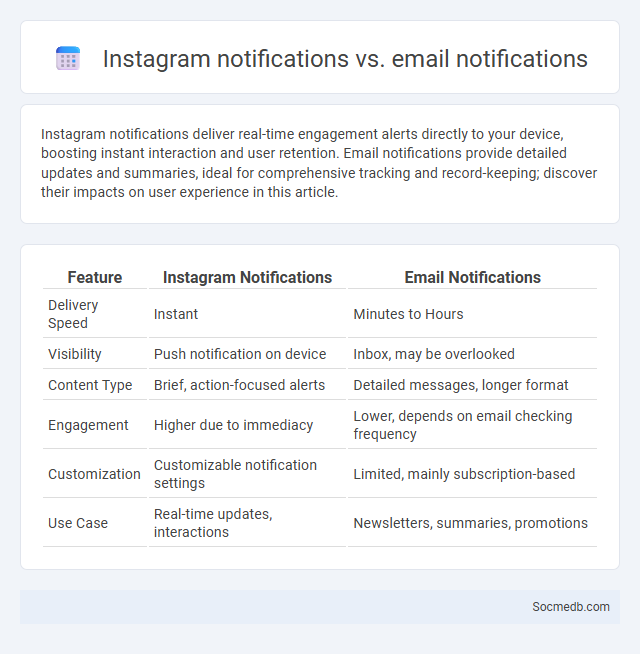
Photo illustration: Instagram Notifications vs Email Notifications
Instagram notifications deliver real-time engagement alerts directly to your device, boosting instant interaction and user retention. Email notifications provide detailed updates and summaries, ideal for comprehensive tracking and record-keeping; discover their impacts on user experience in this article.
Table of Comparison
| Feature | Instagram Notifications | Email Notifications |
|---|---|---|
| Delivery Speed | Instant | Minutes to Hours |
| Visibility | Push notification on device | Inbox, may be overlooked |
| Content Type | Brief, action-focused alerts | Detailed messages, longer format |
| Engagement | Higher due to immediacy | Lower, depends on email checking frequency |
| Customization | Customizable notification settings | Limited, mainly subscription-based |
| Use Case | Real-time updates, interactions | Newsletters, summaries, promotions |
Introduction to Notification Types
Social media platforms utilize various notification types to keep you engaged and informed, including push notifications, email alerts, and in-app notifications. Each type serves a specific purpose, such as instant updates about messages, comments, or friend requests. Understanding these notification methods helps you manage interactions and stay connected without feeling overwhelmed.
Overview of Instagram Notifications
Instagram notifications provide real-time alerts for likes, comments, new followers, direct messages, and story views to enhance user engagement. Users can customize notification settings within the app to receive updates on specific activities such as photo tags, live videos, and IGTV releases. These notifications play a crucial role in maintaining active communication and increasing content visibility on the platform.
Understanding Email Notifications
Understanding email notifications in social media platforms is crucial for managing user engagement and communication preferences. These notifications often include alerts about new messages, friend requests, comments, or activity on posts, designed to keep users informed and active. Optimizing email notification settings improves user experience by reducing spam and ensuring timely, relevant updates.
General App and Device Notifications Explained
General app and device notifications deliver real-time alerts to users about updates, messages, or activities within social media platforms, enhancing user engagement and timely interaction. These notifications can include likes, comments, friend requests, event reminders, or security alerts, tailored through settings to optimize user experience. Efficient management of notification preferences across devices ensures relevant information is received without overwhelming users, maintaining a balanced digital presence.
User Engagement: Instagram vs Email vs Generic Notifications
Instagram drives high user engagement through visually rich content and interactive features like Stories, Reels, and polls, capturing users' attention effectively. Email offers personalized communication with targeted content, fostering deeper connections and encouraging action through tailored messages directly in Your inbox. Generic notifications lack personalization and contextual relevance, often resulting in lower engagement rates compared to the immersive experiences provided by Instagram and email marketing.
Customization and Control: Comparing Notification Settings
Social media platforms offer extensive customization and control over notification settings, allowing users to tailor alerts based on preferences such as activity type, frequency, or device. Features like granular push notification controls on Facebook, filter options on Instagram, and keyword alerts on Twitter enhance user experience by reducing unwanted interruptions. Comparing these settings highlights the importance of personalized notification management in maintaining digital well-being and engagement.
Reach and Visibility: Which Notification Wins?
Push notifications generate higher reach and visibility compared to email alerts by directly engaging users on their devices with real-time updates. Social media platforms like Facebook and Instagram achieve greater visibility through in-app notifications that trigger immediate user interaction. Personalized notifications based on user behavior significantly increase engagement rates and boost overall content reach.
Use Cases: When to Use Instagram, Email, or Device Notifications
Instagram excels for visual storytelling, brand awareness, and engaging younger audiences through images, reels, and stories. Email is ideal for detailed communication, personalized marketing, and transactional messages, offering direct access to your audience's inbox. Device notifications work best for urgent alerts, time-sensitive updates, and driving immediate actions, ensuring your message grabs attention promptly.
Privacy and Security Considerations
Social media platforms collect extensive personal data, making privacy settings and data encryption vital to protect user information from unauthorized access and breaches. Users should be aware of risks such as identity theft, phishing attacks, and data mining while utilizing robust passwords and two-factor authentication for enhanced security. Compliance with regulations like GDPR and CCPA ensures that platforms manage user data responsibly and provide transparency in data handling practices.
Choosing the Right Notification Channel for Your Needs
Selecting the appropriate notification channel is crucial for maximizing engagement and minimizing user fatigue. Consider factors such as audience demographics, platform usage patterns, and message urgency when choosing between push notifications, email alerts, or in-app messages. Tailoring notification delivery based on user preferences and behavior enhances communication effectiveness and supports better social media management.
 socmedb.com
socmedb.com